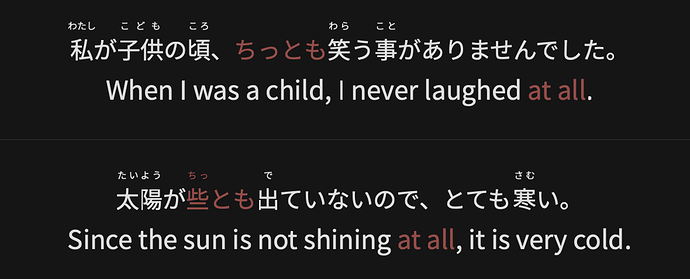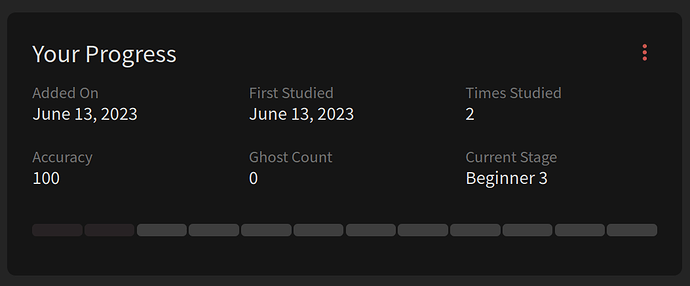Hi, All! 
I am happy to officially announce that we have finished checking and improving all the example sentences in the N5 & N4 vocabulary sections! Our focus of this process was identifying and fixing minor errors, especially in the furigana, or anything unnatural in the Japanese sentences. I’ll go over a few examples of these fixes with you all.
Furigana
In our current system, the furigana for the vocabulary example sentences is added automatically by a program, due to there just being far too many to do manually. As you may know, the furigana for some kanji differs depending on the context, meaning, or word that precedes/follows, so it is important to check them one by one. Here, let me show some examples of the furigana I have changed.
- 二人 (two people):ににん → ふたり
- 一週間 (one week):いちしゅうかん → いっしゅうかん
- 三階建て(three floor building):さんかいだて → さんがいだて
Note: The reading for 階 is かい for 1st, 2nd, 4th… floors, but the 3rd floor is an exception and it is commonly pronounced as さんがい, instead of さんかい. This is an example of rendaku, the regular sound changes in Japanese.
- 大地震 (a big earthquake):だいじしん → おおじしん
Note: Both readings are acceptable. Historically, おおじしん was more commonly used, and it is still the official reading used by major media outlets in Japan. But だいじしん has become more prevalent in daily conversation nowadays as well, though it originally referred to earthquakes with a magnitude of 7 or higher as a technical term. In this case, I have chosen to use おおじしん because it seems that it is still widely recognized as the standard reading. Information on official or preferred readings for words can be found on websites like NHK Broadcasting
- 抱く (hold, embrace):だく ⇄ いだく
Note: This is an example of furigana that changes depending on the context. When you physically hold or embrace something or someone, だく is commonly used, while when you have something abstract like a question, a joy, or an ideal, いだく is used. In cases like this, we will add new sentences for the alternative meanings/readings as well, and link them via the vocabulary description.
Kanji typos
Kanji typos have been also fixed, though there were only a few. This mainly happens when we click tab one too many times selecting kanji while typing quickly! Just let me show you one example that I found funny.
Before 
After 
Alternate characters
Some vocabulary words can be written using different characters, such as kanji, hiragana, katakana, or even a combination of them. In our vocabulary section, we provide multiple possibilities if they are actually used in writing. For example, the word 些とも(ちっとも)‘a tiny bit’ is commonly written in hiragana rather than kanji in our daily life. However, the kanji version can also be seen in books, so in this case, we have included the kanji and hiragana versions in the sentences for practice purposes and exposure to both.
Last but not least, thank you all for your continuous support! I have been impressed by everyone’s passion for learning everyday since I joined the Bunpro team! I hope this update helps make your learning experience better, and that it adds to the reliability of content that we provide! I have just started checking everything in the N3 vocabulary sentences, and am looking forward to polishing this product as well!
Hope you all have a wonderful day! 
Chihiro













